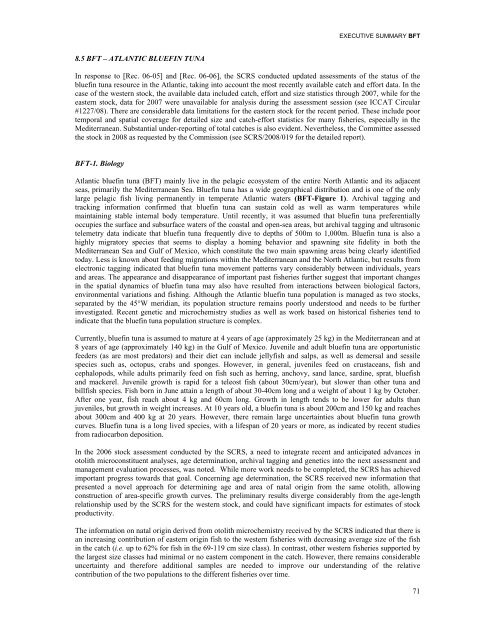REPORT OF THE STANDING COMMITTEE ON RESEARCH ... - Iccat
REPORT OF THE STANDING COMMITTEE ON RESEARCH ... - Iccat
REPORT OF THE STANDING COMMITTEE ON RESEARCH ... - Iccat
Create successful ePaper yourself
Turn your PDF publications into a flip-book with our unique Google optimized e-Paper software.
EXECUTIVE SUMMARY BFT8.5 BFT – ATLANTIC BLUEFIN TUNAIn response to [Rec. 06-05] and [Rec. 06-06], the SCRS conducted updated assessments of the status of thebluefin tuna resource in the Atlantic, taking into account the most recently available catch and effort data. In thecase of the western stock, the available data included catch, effort and size statistics through 2007, while for theeastern stock, data for 2007 were unavailable for analysis during the assessment session (see ICCAT Circular#1227/08). There are considerable data limitations for the eastern stock for the recent period. These include poortemporal and spatial coverage for detailed size and catch-effort statistics for many fisheries, especially in theMediterranean. Substantial under-reporting of total catches is also evident. Nevertheless, the Committee assessedthe stock in 2008 as requested by the Commission (see SCRS/2008/019 for the detailed report).BFT-1. BiologyAtlantic bluefin tuna (BFT) mainly live in the pelagic ecosystem of the entire North Atlantic and its adjacentseas, primarily the Mediterranean Sea. Bluefin tuna has a wide geographical distribution and is one of the onlylarge pelagic fish living permanently in temperate Atlantic waters (BFT-Figure 1). Archival tagging andtracking information confirmed that bluefin tuna can sustain cold as well as warm temperatures whilemaintaining stable internal body temperature. Until recently, it was assumed that bluefin tuna preferentiallyoccupies the surface and subsurface waters of the coastal and open-sea areas, but archival tagging and ultrasonictelemetry data indicate that bluefin tuna frequently dive to depths of 500m to 1,000m. Bluefin tuna is also ahighly migratory species that seems to display a homing behavior and spawning site fidelity in both theMediterranean Sea and Gulf of Mexico, which constitute the two main spawning areas being clearly identifiedtoday. Less is known about feeding migrations within the Mediterranean and the North Atlantic, but results fromelectronic tagging indicated that bluefin tuna movement patterns vary considerably between individuals, yearsand areas. The appearance and disappearance of important past fisheries further suggest that important changesin the spatial dynamics of bluefin tuna may also have resulted from interactions between biological factors,environmental variations and fishing. Although the Atlantic bluefin tuna population is managed as two stocks,separated by the 45°W meridian, its population structure remains poorly understood and needs to be furtherinvestigated. Recent genetic and microchemistry studies as well as work based on historical fisheries tend toindicate that the bluefin tuna population structure is complex.Currently, bluefin tuna is assumed to mature at 4 years of age (approximately 25 kg) in the Mediterranean and at8 years of age (approximately 140 kg) in the Gulf of Mexico. Juvenile and adult bluefin tuna are opportunisticfeeders (as are most predators) and their diet can include jellyfish and salps, as well as demersal and sessilespecies such as, octopus, crabs and sponges. However, in general, juveniles feed on crustaceans, fish andcephalopods, while adults primarily feed on fish such as herring, anchovy, sand lance, sardine, sprat, bluefishand mackerel. Juvenile growth is rapid for a teleost fish (about 30cm/year), but slower than other tuna andbillfish species. Fish born in June attain a length of about 30-40cm long and a weight of about 1 kg by October.After one year, fish reach about 4 kg and 60cm long. Growth in length tends to be lower for adults thanjuveniles, but growth in weight increases. At 10 years old, a bluefin tuna is about 200cm and 150 kg and reachesabout 300cm and 400 kg at 20 years. However, there remain large uncertainties about bluefin tuna growthcurves. Bluefin tuna is a long lived species, with a lifespan of 20 years or more, as indicated by recent studiesfrom radiocarbon deposition.In the 2006 stock assessment conducted by the SCRS, a need to integrate recent and anticipated advances inotolith microconstituent analyses, age determination, archival tagging and genetics into the next assessment andmanagement evaluation processes, was noted. While more work needs to be completed, the SCRS has achievedimportant progress towards that goal. Concerning age determination, the SCRS received new information thatpresented a novel approach for determining age and area of natal origin from the same otolith, allowingconstruction of area-specific growth curves. The preliminary results diverge considerably from the age-lengthrelationship used by the SCRS for the western stock, and could have significant impacts for estimates of stockproductivity.The information on natal origin derived from otolith microchemistry received by the SCRS indicated that there isan increasing contribution of eastern origin fish to the western fisheries with decreasing average size of the fishin the catch (i.e. up to 62% for fish in the 69-119 cm size class). In contrast, other western fisheries supported bythe largest size classes had minimal or no eastern component in the catch. However, there remains considerableuncertainty and therefore additional samples are needed to improve our understanding of the relativecontribution of the two populations to the different fisheries over time.71
















